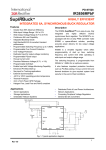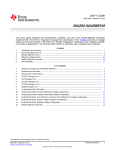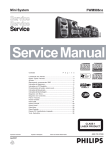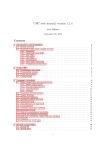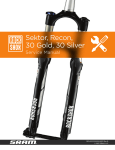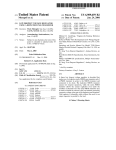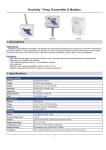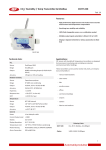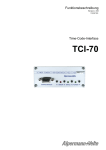Download CDA EVM9 User`s guide
Transcript
User's Guide SBOU074A – January 2009 – Revised February 2010 INA219 Evaluation Module This user’s guide describes the characteristics, operation, and use of the INA219 evaluation module (EVM). It covers all pertinent areas involved to properly use this EVM board. This document includes the physical printed circuit board layout, schematic diagrams, and circuit descriptions. 1 2 3 4 5 Contents Overview ..................................................................................................................... 2 System Setup ................................................................................................................ 4 INA219EVM Hardware Setup ............................................................................................. 7 INA219 Software Overview .............................................................................................. 14 Bill of Materials ............................................................................................................. 20 List of Figures 1 Hardware Included with the INA219EVM ................................................................................ 2 2 INA219EVM Hardware Setup ............................................................................................. 4 3 INA219_Test_Board Block Diagram ...................................................................................... 4 4 INA219_Test_Board Schematic ........................................................................................... 5 5 USB_DIG_Platform Theory of Operation ................................................................................ 7 6 Typical Hardware Connections ............................................................................................ 8 7 Connecting Power to the EVM ............................................................................................ 9 8 Connecting the USB Cable............................................................................................... 10 9 INA219EVM Default Jumper Settings 10 INA219EVM Software—Functioning Properly ......................................................................... 15 11 INA219EVM Software—No Communication with the USB DIG Platform .......................................... 16 12 INA219EVM Software—No Communication with the USB DIG Platform and INA219 ........................... 17 13 EVM Controls Drop-Down Menu ........................................................................................ 19 14 Current Software Revision 1 Signal Definition of J1 (25-Pin Male DSUB) on INA219_Test_Board ................................................ 6 2 INA219_Test_Board Jumper Functions ................................................................................ 11 3 USB DIG Platform Jumper Settings..................................................................................... 12 4 Power-Supply Jumper Configuration #1 ................................................................................ 13 5 Power-Supply Jumper Configuration #2 ................................................................................ 13 6 INA219_Test_Board Parts List .................................................................................. ............................................................................................... 11 19 List of Tables .......................................................................................... 20 Microsoft, Windows are registered trademarks of Microsoft Corporation. I2C is a trademark of NXP Semiconductors. All other trademarks are the property of their respective owners. SBOU074A – January 2009 – Revised February 2010 Submit Documentation Feedback Copyright © 2009–2010, Texas Instruments Incorporated INA219 Evaluation Module 1 Overview 1 www.ti.com Overview This document provides the information needed to set up and operate the INA219EVM evaluation module, a test platform for the INA219, a high-side measurement, bi-directional current/power monitor with I2C interface. For a more detailed description of the INA219, please refer to the product data sheet (SBOS448A) available from the Texas Instruments web site at http://www.ti.com. Additional support documents are listed in the section of this guide entitled Related Documentation from Texas Instruments . The INA219EVM is an evaluation module that is used to fully evaluate the INA219 current/power monitor device. The INA219EVM consists of two printed circuit boards (PCBs). One board (the USB DIG Platform) generates the digital signals required to communicate with the INA219, which is part of the second board (INA219_Test_Board), as well as support and configuration circuitry. Throughout this document, the abbreviation EVM and the term evaluation module are synonymous with the INA219EVM. 1.1 INA219EVM Hardware Figure 1 shows the hardware included with the INA219EVM kit. Contact the factory if any component is missing. It is highly recommended that you check the TI web site at http://www.ti.com to verify that you have the latest software. It is also recommended that you watch the QuickStart Video (included on the compact disk) before using the INA219EVM. Figure 1. Hardware Included with the INA219EVM 2 INA219 Evaluation Module SBOU074A – January 2009 – Revised February 2010 Submit Documentation Feedback Copyright © 2009–2010, Texas Instruments Incorporated Overview www.ti.com The complete kit includes the following items: • INA219 test PCB • USB DIG platform PCB • USB cable • +6V power supply • CD-ROM containing this user's guide, product software, and a demonstration video 1.2 Related Documentation from Texas Instruments The following document provides information regarding Texas Instruments integrated circuits used in the assembly of the INA219EVM. This user's guide is available from the TI web site under literature number SBOU074. Any letter appended to the literature number corresponds to the document revision that is current at the time of the writing of this document. Newer revisions may be available from the TI web site at http://www.ti.com/, or call the Texas Instruments Literature Response Center at (800) 477-8924 or the Product Information Center at (972) 644-5580. When ordering, identify the document by both title and literature number. 1.3 Document Literature Number INA219 Product Data Sheet SBOS448A USB DIG Platform Users Guide SBOU058 Information About Cautions and Warnings This document contains caution statements. CAUTION This is an example of a caution statement. A caution statement describes a situation that could potentially damage your software or equipment. The information in a caution or a warning is provided for your protection. Please read each caution carefully. SBOU074A – January 2009 – Revised February 2010 Submit Documentation Feedback Copyright © 2009–2010, Texas Instruments Incorporated INA219 Evaluation Module 3 System Setup 2 www.ti.com System Setup Figure 2 shows the system setup for the INA219EVM. The PC runs software that communicates with the USB DIG Platform. The USB DIG Platform generates the analog and digital signals used to communicate with the INA219_Test_Board. Connectors on the INA219_Test_Board allow the user to connect to the system under test whose power, current, and voltage will be monitored. System on which we will measure Shunt Current, Bus Voltage, and Power System Load Shunt Resistor EVM Power System Power INA219 Test Board USB DIG Platform Figure 2. INA219EVM Hardware Setup 2.1 Theory of Operation for INA219_Test_Board Hardware Figure 3 presents a block diagram of the INA219_Test_Board. The functionality of this PCB is relatively simple. It provides connections to the I2C™ and general-purpose input/outputs (GPIO) on the USB DIG Platform board. It also provides connection points for external connections of the shunt voltage, bus voltage, and GND. VDUT Supply Switched 5.0V Power 25-Pin Male DSUB Signals From USB DIG Platform Connection to Shunt Voltage and GND 2 IC Address Jumpers 2 IC Interface INA219 Figure 3. INA219_Test_Board Block Diagram 4 INA219 Evaluation Module SBOU074A – January 2009 – Revised February 2010 Submit Documentation Feedback Copyright © 2009–2010, Texas Instruments Incorporated System Setup www.ti.com Figure 4 illustrates the system setup for the INA219_Test_Board schematic. D1 is an LED that indicates whether the INA219 Test Board is receiving power. Jumpers allow the selection of the power source as well as configuration of A0 and A1. Connector T4 allows the connection of the shunt and bus voltages. Figure 4. INA219_Test_Board Schematic SBOU074A – January 2009 – Revised February 2010 Submit Documentation Feedback Copyright © 2009–2010, Texas Instruments Incorporated INA219 Evaluation Module 5 System Setup 2.2 www.ti.com Signal Definitions of J1 (25-Pin Male DSUB) Table 1 lists the different signals connected to J1 on the INA219_Test_Board. This table also identifies signals connected to pins on J1 that are not used on the INA219_Test_Board. Table 1. Signal Definition of J1 (25-Pin Male DSUB) on INA219_Test_Board 6 J1 Pin Signal INA219 Pin 1 NC No connection 2 NC No connection 3 NC No connection 4 NC No connection 5 NC No connection 6 NC No connection 7 NC No connection 8 NC No connection 9 I2C_SCK No connection 10 I2C_SDA2 No connection 11 NC No connection 12 I2C_SCK_ISO I2C clock signal (SCL) channel 1; can be disconnected using a switch 13 I2C_SDA_ISO I2C data signal (SDA) channel 1; can be disconnected using a switch 14 NC No connection 15 NC No connection 16 NC No connection 17 VDUT Switched 3V or 5V power. Note that when power is switched off, the digital I/O is also switched off. 18 VCC No connection 19 NC No connection 20 NC No connection 21 GND Common or ground connection for power 22 SPI_SCK No connection 23 SPI_CS1 No connection 24 SPI_DOUT No connection 25 SPI_DIN1 No connection INA219 Evaluation Module SBOU074A – January 2009 – Revised February 2010 Submit Documentation Feedback Copyright © 2009–2010, Texas Instruments Incorporated INA219EVM Hardware Setup www.ti.com 2.3 Theory of Operation For USB_DIG_Platform Figure 5 shows the block diagram for the USB DIG Platform. This platform is a general-purpose data acquisition system that is used on several different Texas Instruments evaluation modules. The details of its operation are included in a separate document (available for download at www.ti.com). The block diagram shown in Figure 5 gives a brief overview of the platform. The primary control device on the USB DIG Platform is the TUSB3210. External Power Adjustable Regulator VCC (2.7V to 5.5V) 3.3V Regulator USB Connection from Computer TUSB3210 8052 mC with USB Interface and UART Reset Button and Power-On Reset VDUT (2.7V to 5.5V) Switched Power USB DIG EVM VS mC 3.3V VUSB 5V Power Switching 2 Buffers and Latches IC SPI Control Bits Measure Bits 8Kx8-Byte EEPROM Figure 5. USB_DIG_Platform Theory of Operation 3 INA219EVM Hardware Setup The INA219EVM hardware setup involves connecting the two PCBs of the EVM together, applying power, connecting the USB cable, and setting the jumpers. This section presents the details of this procedure. 3.1 Electrostatic Discharge Warning Many of the components on the INA219EVM are susceptible to damage by electrostatic discharge (ESD). Customers are advised to observe proper ESD handling precautions when unpacking and handling the EVM, including the use of a grounded wrist strap at an approved ESD workstation. CAUTION Failure to observe ESD handling procedures may result in damage to EVM components. SBOU074A – January 2009 – Revised February 2010 Submit Documentation Feedback Copyright © 2009–2010, Texas Instruments Incorporated INA219 Evaluation Module 7 INA219EVM Hardware Setup 3.2 www.ti.com Typical Hardware Connections The INA219EVM hardware setup involves connecting the two PCBs of the EVM together, applying power, and connecting an external shunt and load. The external connections may be the real-world system that the INA219 will be incorporated into. Figure 6 shows the typical hardware connections. Figure 6. Typical Hardware Connections 3.3 Connecting the Hardware To connect the two PCBs of the INA219EVM together, gently push on both sides of the D-SUB connectors (as shown in Figure 7). Make sure that the two connectors are completely pushed together; loose connections may cause intermittent operation. 8 INA219 Evaluation Module SBOU074A – January 2009 – Revised February 2010 Submit Documentation Feedback Copyright © 2009–2010, Texas Instruments Incorporated INA219EVM Hardware Setup www.ti.com 3.4 Connecting Power After the two parts of the INA219 EVM are connected, as shown in Figure 7, connect the power to the EVM. Always connect power before connecting the USB cable. If you connect the USB cable before connecting the power, the computer will attempt to communicate with an unpowered device that will not be able to respond. Figure 7. Connecting Power to the EVM SBOU074A – January 2009 – Revised February 2010 Submit Documentation Feedback Copyright © 2009–2010, Texas Instruments Incorporated INA219 Evaluation Module 9 INA219EVM Hardware Setup 3.5 www.ti.com Connecting the USB Cable to the INA219EVM Figure 8 shows the typical response to connecting the USB DIG platform to a PC USB port for the first time. Note that the EVM must be powered on before connecting the USB cable. Typically, the computer will respond with a Found New Hardware, USB Device pop-up. The pop-up typically changes to Found New Hardware, USB Human Interface Device. This pop-up indicates that the device is ready to be used. The USB DIG platform uses the Human Interface Device Drivers that are part of the Microsoft® Windows® operating system. In some cases, the Windows Add Hardware Wizard will pop up. If this prompt occurs, allow the system device manager to install the Human Interface Drivers by clicking Yes when requested to install drivers. Figure 8. Connecting the USB Cable 10 INA219 Evaluation Module SBOU074A – January 2009 – Revised February 2010 Submit Documentation Feedback Copyright © 2009–2010, Texas Instruments Incorporated INA219EVM Hardware Setup www.ti.com 3.6 INA219 Jumper Settings Figure 9 shows the default jumpers configuration for the INA219EVM. In general, the jumper settings of the USB DIG Platform will not need to be changed. You may want to change some of the jumpers on the INA219_Test_Board to match your specific configuration. For instance, you may wish to set a specific I2C address. Figure 9. INA219EVM Default Jumper Settings Table 2 explains the function of the jumpers on the INA219_Test_Board. Table 2. INA219_Test_Board Jumper Functions Jumper Default Purpose JMP1 VDUT This jumper determines the source for the INA219 power supply. In the Vdut position, the USB DIG board supplies the power to the INA219. In the Vs_Ext position, an external supply connected to the INA219 T3 terminal supplies power. JMP2, JMP3 JMP2 (GND) A0 address input selection. This jumper determines which signal is connected to the A0 pin of the INA219. JMP4, JMP5 JMP4 (GND) A1 address input selection. This jumper determines which signal is connected to the A1 pin of the INA219. SBOU074A – January 2009 – Revised February 2010 Submit Documentation Feedback Copyright © 2009–2010, Texas Instruments Incorporated INA219 Evaluation Module 11 INA219EVM Hardware Setup www.ti.com Table 3 indicates the function and default position of the USB-DIG-Platform jumpers. For most applications, the default jumper position should be used. Table 4 and Table 5 describe the options for the power-supply configuration. For example, the logic power supply can be changed from the default of 5V to 3V. A separate document (SBOU058) gives details regarding the operation and design of the USB DIG platform. Table 3. USB DIG Platform Jumper Settings Jumper Default Purpose JUMP1 EXT This jumper selects external power or bus power. External power is applied on J5 or T3 (9VDC). Bus power is 5V from the USB. External power is typically used because the USB power is noisy. JUMP2 EXT Same as JUMP1. JUMP3 EE ON JUMP4, JUMP5 L, L This jumper sets the address for the USB board. The only reason to change from the default setting is if multiple boards are being used. JUMP9 5V This selects the voltage of the device under test supply (VDUT = 5V or 3V). This jumper is typically the only jumper that is changed for most applications. JUMP10 WP ON This write-protects the firmware EEPROM. JUMP11 WP ON This write-protects the calibration EEPROM. JUMP13 Reg JUMP14 9V JUMP17 BUS This jumper determines where the TUSB3210 will load the USB DIG Platform firmware upon power-up or reset. The EE Off position is used for development for development or firmware updates. Uses the regulator output to generate the VDUT supply. The USB can be used as the VDUT supply. Uses the external power (9V as apposed to the bus) While in the BUS position, VDUT operation is normal. While in the VRAW position, the VDUT supply is connected to an external source. This flexibility allows for any value of VDUT between 3V and 5V. CAUTION When JUMP17 is in the VRAW position, adjusting the VDUT voltage beyond the 3V to 5V range will damage the EVM. JUMP18 12 INA219 Evaluation Module VDUT Connects the pull-up on the GPIO to the VDUT supply or the VCC supply. SBOU074A – January 2009 – Revised February 2010 Submit Documentation Feedback Copyright © 2009–2010, Texas Instruments Incorporated INA219EVM Hardware Setup www.ti.com Table 4. Power-Supply Jumper Configuration #1 Mode Jumper Comment External Power—5V (default jumper settings) JUMP17 = BUS (not used) JUMP13 = REG JUMP14 = 9V JUMP1 = EXT JUMP2 = EXT JUMP6 = 5V JUMP7 = REF In this mode, all power is supplied to the EVM via J5 or T3. The external supply must be between 5.8V and 10.4V for proper operation. All digital I/Os are regulated to 5V using U19 (REG101). External Power—3V (typical jumper settings) JUMP17 = BUS (not used) JUMP13 = REG JUMP14 = 9V JUMP1 = EXT JUMP2 = EXT JUMP6 = 3V JUMP7 = REF In this mode, all power is supplied to the EVM via J5 or T3. The external supply must be between 5.8V and 10.4V for proper operation. All digital I/Os are regulated to 3V using U19 (REG101). External Power—Variable Supply JUMP17 = Vraw JUMP13 = BUS JUMP14 = 9V (not used) JUMP1 = EXT JUMP2 = EXT JUMP6 = 5V (not used) JUMP7 = REG (ratiometric mode) In this mode, all the digital I/Os are referenced to the supply that is attached to either J5 or T3. CAUTION It is absolutely critical that the supply voltage does not exceed 5.5V in this mode. The supply is directly applied to devices with 5.5V absolute maximum ratings. This mode of operation is useful when a device supply other then 3.0V or 5.0V is required. Table 5. Power-Supply Jumper Configuration #2 Mode Jumper Comment Bus Power—5V JUMP17 = BUS JUMP13 = BUS JUMP14 = 9V (not used) JUMP1 = BUS JUMP2 = BUS JUMP6 = 5V (not used) JUMP7 = REG (ratiometric mode, 5V supply) In this mode, the USB bus completely powers the EVM. The USB bus is regulated by the master (computer) to be 5V. This mode relies upon external regulation. This mode is recommended only when an external 9V supply is not available. If an external 9V supply is available, use either External Power 5V mode or External Power 3V mode. Bus Power—3V JUMP17 = BUS (not used) JUMP13 = REG JUMP14 = BUS JUMP1 = BUS JUMP2 = BUS JUMP6 = 3V JUMP7 = REG (ratiometric mode, 5V supply) In this mode, the USB bus completely powers the EVM. The regulator (U19, REG101) is used to generate a 3V supply for all digital I/O. SBOU074A – January 2009 – Revised February 2010 Submit Documentation Feedback Copyright © 2009–2010, Texas Instruments Incorporated INA219 Evaluation Module 13 INA219 Software Overview 3.7 www.ti.com Connecting External Power to the INA219EVM The INA219 power supply (VS) operates over the range of 3V to 5.5V (see the INA219 product data sheet). The default jumper position provides 5V to the INA219 from the USB-DIG-Platform. The power from the USB-DIG-Platform can be changed to 3V using JUMP9. Another option is to connect power to the INA219 power supply (VS) using an external power supply. In this case, connect power to the T3 terminal block and set JMP1 to the Vs_EXT positon. The INA219 power supply (VS) operates over the range of 3V to 5.5V, so be careful to not exceed this range. 3.8 Connecting External Signals to the INA219EVM The INA219 shunt and bus voltages are applied via terminal block T4. The T4 terminal block is a direct connection to VIN+ and VIN– of the INA219. The bus voltage is monitored on VIN– (26V max). The shunt voltage is the difference between VIN– and VIN+ (320mV max). Refer to the INA219 data sheet for more details 4 INA219 Software Overview This section discusses how to install and use the INA219 software. 4.1 Operating Systems for INA219 Software The INA219EVM software has been tested on the Microsoft Windows XP operating system (OS) with United States and European regional settings. The software should also function on other Windows operating systems. 14 INA219 Evaluation Module SBOU074A – January 2009 – Revised February 2010 Submit Documentation Feedback Copyright © 2009–2010, Texas Instruments Incorporated INA219 Software Overview www.ti.com 4.2 INA219EVM Software Install Follow these steps to install the INA219EVM software: Step 1. Software can be downloaded from the INA219EVM web page, or from the disk included with the INA219EVM, which contains a folder called Install_software/. Step 2. Find the file called setup.exe. Double-click the file to start the installation process. Step 3. Follow the on-screen prompts to install the software. Step 4. To remove the application, use the Windows Control Panel utility, Add/Remove Software. The INA219 Quick-Start Video (included with the kit) gives more detail regarding the initialization of the software. 4.3 Starting the INA219EVM Software The INA219 software can be operated through the Windows Start menu. From Start, select All Programs; then select the INA219EVM program. Figure 10 shows how the software should appear if the EVM is functioning properly. Figure 10. INA219EVM Software—Functioning Properly SBOU074A – January 2009 – Revised February 2010 Submit Documentation Feedback Copyright © 2009–2010, Texas Instruments Incorporated INA219 Evaluation Module 15 INA219 Software Overview www.ti.com Figure 11 shows an error that pops up if the computer cannot communicate with the EVM. If you receive this error, first check to see that the USB cable is properly connected. This error can also occur if you connect the USB cable before the USB DIG Platform 9V power source. A second possible reason for this problem is that there may be a problem with your computer USB Human Interface Device Driver. Make sure that when you plug the in the USB cable, the computer recognizes the device. If the sound is on, you will hear the distinctive sound that you expect when a USB device is properly connected to the PC. Figure 11. INA219EVM Software—No Communication with the USB DIG Platform 16 INA219 Evaluation Module SBOU074A – January 2009 – Revised February 2010 Submit Documentation Feedback Copyright © 2009–2010, Texas Instruments Incorporated INA219 Software Overview www.ti.com Figure 12 shows an error that occurs if the INA219_Test_Board is not communicating with the USB DIG Platform. If you see this error, check the connectors between the two boards; make sure the 25-pin connectors are completely pushed together. Another possible cause of this issue it that the INA219_Test_Board jumpers are set in the wrong position. Figure 12. INA219EVM Software—No Communication with the USB DIG Platform and INA219 SBOU074A – January 2009 – Revised February 2010 Submit Documentation Feedback Copyright © 2009–2010, Texas Instruments Incorporated INA219 Evaluation Module 17 INA219 Software Overview 4.4 www.ti.com Using the INA219 Software The INA219EVM software has six different tabs that allow you to access different features of the INA219. The first four tabs are designed so that you can completely configure the device by stepping through the tabs in order. Each of the tabs is intended to have an intuitive graphical interface that helps you gain a better understanding of the device. 4.4.1 Overview Tab This tab has the following controls: • Turn the power supply on and off • Set the I2C address 4.4.2 Config Tab This tab has the following controls: • Shunt voltage attenuator range (smallest range: 40mV; largest range: 320mV) • Shunt voltage configuration: resolution and number of averages. Note that increasing the number of averages decreases the noise but slows down the conversion rate. • Bus voltage attenuator range (16V and 32V): Note that the maximum bus voltage for the INA219 is 26V. Thus, the 32V range cannot be fully used. • Bus voltage configuration: Resolution and number of averages. Note that increasing the number of averages decreases noise but slows down the conversion rate. • A/D converter mode: This control determines how the converters work. The most commonly used modes are Shunt and Bus continuous conversion mode. This mode causes both converters to run continuously. More details on these options are explained in the product data sheet. 4.4.3 Calibrate Tab The calibration tab allows users to enter some information regarding the INA219 configuration in a given application. This information is used to compute the Full-Scale Cal Register. The Full-Scale Cal Register converts the shunt voltage to a current value. The detailed mathematics behind this calibration feature is given in the INA219 data sheet. Also, this feature is explained in a step-by-step manner in the video. 4.4.4 Scaling Tab This tab allows you to see how the mathematical operations work in the INA219. Specifically, this tab shows how the current and power values are computed using the full-scale calibration register. 4.4.5 Graph Tab The graph tab will display bus voltage, shunt current, and power versus time when the software is in continuous convert mode. 4.4.6 Registers Tab This tab allows you to read and edit all the registers in the INA219. All the previous tabs affect the register listing. For example, changing the A/D configuration on Tab 2 will affect Register 0 in the register list. It is also true that changing register 0 updates the A/D configuration on Tab 2. Thus, the graphical representation and register representation affect each other. 18 INA219 Evaluation Module SBOU074A – January 2009 – Revised February 2010 Submit Documentation Feedback Copyright © 2009–2010, Texas Instruments Incorporated INA219 Software Overview www.ti.com 4.4.7 EVM Controls Pull-Down Menu The INA219 Configuration (that is, the register settings) can be saved or loaded using the EVM Controls drop-down menu, as Figure 13 shows. The file that the configuration is saved into is a simple text file and can be viewed with any text editor. Figure 13. EVM Controls Drop-Down Menu 4.4.8 Software Revision The Help...About feature can be used to check the current software revision, as Figure 14 illustrates. This document is based on revision 1.0.35. Figure 14. Current Software Revision SBOU074A – January 2009 – Revised February 2010 Submit Documentation Feedback Copyright © 2009–2010, Texas Instruments Incorporated INA219 Evaluation Module 19 Bill of Materials 5 www.ti.com Bill of Materials Table 6 shows the parts list for the INA219_Test_Board. Table 6. INA219_Test_Board Parts List 20 No. Quantity Value Ref Des 1 1 4.02k R5 Description Vendor Part Number Resistor, 4.02k, 603 ROHM MCR03EZPFX4021 2 2 10k R3, R4 Resistor, 10k, 603 Yageo Corporation RC0603FR-0710KL 3 2 0ohm R1, R2 RES 0.0 OHM 1/8W 5% 0805 SMD Panasonic - ECG ERJ-6GEY0R00V 4 1 10uF C3 Capacitor, Tantalum, 10uF, 16V, 6032 Kemet T491C106M016AT 5 1 0.1uF C2 CAP .10UF 25V CERAMIC Y5V 0603 Kemet C0603C104M3VACTU 6 0 Optional/Not Installed C1 0603-1206 Capacitor — — 7 1 LED D1 Diode, LED, Ultra Bright Diff, 603 Panasonic LNJ208R8ARA 8 1 DSUB25M J1 CONN D-SUB PLUG R/A 25POS 30GOLD (With Threaded Inserts and Board locks) AMP/Tyco Electronics 5747842-4 9 3 N/A N/A SHUNT LP W/HANDLE 2 POS 30AU AMP/Tyco Electronics 881545-2 10 5 JUMP3 cut to size JMP1-JMP5 CONN HEADER 32POS .100" SGL GOLD (4 per Strip) Samtec TSW-132-07-G-S 11 5 standoff none Standoffs, Hex , 4-40 Threaded, 0.500" length, 0.250" OD, Aluminum Iridite Finish Keystone 2203 12 5 screw none SCREW MACHINE PHIL 4-40X1/4 SS Building Fasteners PMSSS 440 0025 PH 13 10 Test Point N/A 5018 SMD Test Point Keystone 5018 14 4 2 pin connector T1 T2 T3 T4 On-Shore Technology Inc ED300/2 INA219 Evaluation Module 2-Position Terminal Strip, Cage Clamp, 45º, 15A, Dove-tailed SBOU074A – January 2009 – Revised February 2010 Submit Documentation Feedback Copyright © 2009–2010, Texas Instruments Incorporated Revision History www.ti.com Revision History Changes from Original (January, 2009) to A Revision ................................................................................................... Page • • • • Revised Table 3 ......................................................................................................................... Added Table 4 and Table 5 ............................................................................................................ Added Section 3.7 ...................................................................................................................... Added Section 3.8 ...................................................................................................................... 12 13 14 14 NOTE: Page numbers for previous revisions may differ from page numbers in the current version. SBOU074A – January 2009 – Revised February 2010 Submit Documentation Feedback Copyright © 2009–2010, Texas Instruments Incorporated Revision History 21 Evaluation Board/Kit Important Notice Texas Instruments (TI) provides the enclosed product(s) under the following conditions: This evaluation board/kit is intended for use for ENGINEERING DEVELOPMENT, DEMONSTRATION, OR EVALUATION PURPOSES ONLY and is not considered by TI to be a finished end-product fit for general consumer use. Persons handling the product(s) must have electronics training and observe good engineering practice standards. As such, the goods being provided are not intended to be complete in terms of required design-, marketing-, and/or manufacturing-related protective considerations, including product safety and environmental measures typically found in end products that incorporate such semiconductor components or circuit boards. This evaluation board/kit does not fall within the scope of the European Union directives regarding electromagnetic compatibility, restricted substances (RoHS), recycling (WEEE), FCC, CE or UL, and therefore may not meet the technical requirements of these directives or other related directives. Should this evaluation board/kit not meet the specifications indicated in the User’s Guide, the board/kit may be returned within 30 days from the date of delivery for a full refund. THE FOREGOING WARRANTY IS THE EXCLUSIVE WARRANTY MADE BY SELLER TO BUYER AND IS IN LIEU OF ALL OTHER WARRANTIES, EXPRESSED, IMPLIED, OR STATUTORY, INCLUDING ANY WARRANTY OF MERCHANTABILITY OR FITNESS FOR ANY PARTICULAR PURPOSE. The user assumes all responsibility and liability for proper and safe handling of the goods. Further, the user indemnifies TI from all claims arising from the handling or use of the goods. Due to the open construction of the product, it is the user’s responsibility to take any and all appropriate precautions with regard to electrostatic discharge. EXCEPT TO THE EXTENT OF THE INDEMNITY SET FORTH ABOVE, NEITHER PARTY SHALL BE LIABLE TO THE OTHER FOR ANY INDIRECT, SPECIAL, INCIDENTAL, OR CONSEQUENTIAL DAMAGES. TI currently deals with a variety of customers for products, and therefore our arrangement with the user is not exclusive. TI assumes no liability for applications assistance, customer product design, software performance, or infringement of patents or services described herein. Please read the User’s Guide and, specifically, the Warnings and Restrictions notice in the User’s Guide prior to handling the product. This notice contains important safety information about temperatures and voltages. For additional information on TI’s environmental and/or safety programs, please contact the TI application engineer or visit www.ti.com/esh. No license is granted under any patent right or other intellectual property right of TI covering or relating to any machine, process, or combination in which such TI products or services might be or are used. FCC Warning This evaluation board/kit is intended for use for ENGINEERING DEVELOPMENT, DEMONSTRATION, OR EVALUATION PURPOSES ONLY and is not considered by TI to be a finished end-product fit for general consumer use. It generates, uses, and can radiate radio frequency energy and has not been tested for compliance with the limits of computing devices pursuant to part 15 of FCC rules, which are designed to provide reasonable protection against radio frequency interference. Operation of this equipment in other environments may cause interference with radio communications, in which case the user at his own expense will be required to take whatever measures may be required to correct this interference. EVM Warnings and Restrictions It is important to operate this EVM within the input voltage range of 5.7V to 9V and the output voltage range of 0V to 5V. Exceeding the specified input range may cause unexpected operation and/or irreversible damage to the EVM. If there are questions concerning the input range, please contact a TI field representative prior to connecting the input power. Applying loads outside of the specified output range may result in unintended operation and/or possible permanent damage to the EVM. Please consult the EVM User's Guide prior to connecting any load to the EVM output. If there is uncertainty as to the load specification, please contact a TI field representative. During normal operation, some circuit components may have case temperatures greater than +25°C. The EVM is designed to operate properly with certain components above +25°C as long as the input and output ranges are maintained. These components include but are not limited to linear regulators, switching transistors, pass transistors, and current sense resistors. These types of devices can be identified using the EVM schematic located in the EVM User's Guide. When placing measurement probes near these devices during operation, please be aware that these devices may be very warm to the touch. Mailing Address: Texas Instruments, Post Office Box 655303, Dallas, Texas 75265 Copyright © 2010, Texas Instruments Incorporated IMPORTANT NOTICE Texas Instruments Incorporated and its subsidiaries (TI) reserve the right to make corrections, modifications, enhancements, improvements, and other changes to its products and services at any time and to discontinue any product or service without notice. Customers should obtain the latest relevant information before placing orders and should verify that such information is current and complete. All products are sold subject to TI’s terms and conditions of sale supplied at the time of order acknowledgment. TI warrants performance of its hardware products to the specifications applicable at the time of sale in accordance with TI’s standard warranty. Testing and other quality control techniques are used to the extent TI deems necessary to support this warranty. Except where mandated by government requirements, testing of all parameters of each product is not necessarily performed. TI assumes no liability for applications assistance or customer product design. Customers are responsible for their products and applications using TI components. To minimize the risks associated with customer products and applications, customers should provide adequate design and operating safeguards. TI does not warrant or represent that any license, either express or implied, is granted under any TI patent right, copyright, mask work right, or other TI intellectual property right relating to any combination, machine, or process in which TI products or services are used. Information published by TI regarding third-party products or services does not constitute a license from TI to use such products or services or a warranty or endorsement thereof. Use of such information may require a license from a third party under the patents or other intellectual property of the third party, or a license from TI under the patents or other intellectual property of TI. Reproduction of TI information in TI data books or data sheets is permissible only if reproduction is without alteration and is accompanied by all associated warranties, conditions, limitations, and notices. Reproduction of this information with alteration is an unfair and deceptive business practice. TI is not responsible or liable for such altered documentation. Information of third parties may be subject to additional restrictions. Resale of TI products or services with statements different from or beyond the parameters stated by TI for that product or service voids all express and any implied warranties for the associated TI product or service and is an unfair and deceptive business practice. TI is not responsible or liable for any such statements. TI products are not authorized for use in safety-critical applications (such as life support) where a failure of the TI product would reasonably be expected to cause severe personal injury or death, unless officers of the parties have executed an agreement specifically governing such use. Buyers represent that they have all necessary expertise in the safety and regulatory ramifications of their applications, and acknowledge and agree that they are solely responsible for all legal, regulatory and safety-related requirements concerning their products and any use of TI products in such safety-critical applications, notwithstanding any applications-related information or support that may be provided by TI. Further, Buyers must fully indemnify TI and its representatives against any damages arising out of the use of TI products in such safety-critical applications. TI products are neither designed nor intended for use in military/aerospace applications or environments unless the TI products are specifically designated by TI as military-grade or "enhanced plastic." Only products designated by TI as military-grade meet military specifications. Buyers acknowledge and agree that any such use of TI products which TI has not designated as military-grade is solely at the Buyer's risk, and that they are solely responsible for compliance with all legal and regulatory requirements in connection with such use. TI products are neither designed nor intended for use in automotive applications or environments unless the specific TI products are designated by TI as compliant with ISO/TS 16949 requirements. Buyers acknowledge and agree that, if they use any non-designated products in automotive applications, TI will not be responsible for any failure to meet such requirements. Following are URLs where you can obtain information on other Texas Instruments products and application solutions: Products Applications Amplifiers amplifier.ti.com Audio www.ti.com/audio Data Converters dataconverter.ti.com Automotive www.ti.com/automotive DLP® Products www.dlp.com Communications and Telecom www.ti.com/communications DSP dsp.ti.com Computers and Peripherals www.ti.com/computers Clocks and Timers www.ti.com/clocks Consumer Electronics www.ti.com/consumer-apps Interface interface.ti.com Energy www.ti.com/energy Logic logic.ti.com Industrial www.ti.com/industrial Power Mgmt power.ti.com Medical www.ti.com/medical Microcontrollers microcontroller.ti.com Security www.ti.com/security RFID www.ti-rfid.com Space, Avionics & Defense www.ti.com/space-avionics-defense RF/IF and ZigBee® Solutions www.ti.com/lprf Video and Imaging www.ti.com/video Wireless www.ti.com/wireless-apps Mailing Address: Texas Instruments, Post Office Box 655303, Dallas, Texas 75265 Copyright © 2010, Texas Instruments Incorporated























